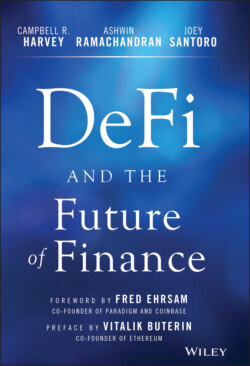DeFi and the Future of Finance

Реклама. ООО «ЛитРес», ИНН: 7719571260.
Оглавление
Campbell R. Harvey. DeFi and the Future of Finance
Table of Contents
List of Tables
List of Illustrations
Guide
Pages
DeFi and the FUTURE of FINANCE
FOREWORD
PREFACE
I INTRODUCTION
FIVE KEY PROBLEMS OF CENTRALIZED FINANCIAL SYSTEMS
IMPLICATIONS
NOTES
II THE ORIGINS OF MODERN DECENTRALIZED FINANCE. A BRIEF HISTORY OF FINANCE
FINTECH
BITCOIN AND CRYPTOCURRENCY
ETHEREUM AND DeFi
NOTES
III DeFi INFRASTRUCTURE
BLOCKCHAIN
CRYPTOCURRENCY
THE SMART CONTRACT PLATFORM
ORACLES
STABLECOINS
DECENTRALIZED APPLICATIONS
NOTES
IV DeFi PRIMITIVES
TRANSACTIONS
FUNGIBLE TOKENS
Equity Token
Utility Tokens
Governance Tokens
NON-FUNGIBLE TOKENS
NFT Standard
Multitoken Standard
CUSTODY
SUPPLY ADJUSTMENT
Burn: Reduce Supply
Mint: Increase Supply
Bonding Curve: Pricing Supply
INCENTIVES
Staking Rewards
Slashing (Staking Penalties)
Direct Rewards and Keepers
Fees
SWAP
Order-Book Matching
Automated Market Makers
COLLATERALIZED LOANS
FLASH (UNCOLLATERALIZED) LOANS
NOTES
V PROBLEMS DeFi SOLVES
INEFFICIENCY
Keepers
Forking
LIMITED ACCESS
Yield Farming
Initial DeFi Offering
OPACITY
Smart Contracts
CENTRALIZED CONTROL
Decentralized Autonomous Organization
LACK OF INTEROPERABILITY
Tokenization
Networked Liquidity
VI DeFi DEEP DIVE
CREDIT/LENDING. MakerDAO
Compound
Aave
DECENTRALIZED EXCHANGE. Uniswap
DERIVATIVES. Yield Protocol
dYdX
Synthetix
TOKENIZATION
Set Protocol
Wrapped Bitcoin
NOTES
VII RISKS
SMART CONTRACT RISK
GOVERNANCE RISK
ORACLE RISK
SCALING RISK
DEX RISK
CUSTODIAL RISK
ENVIRONMENTAL RISK
REGULATORY RISK
NOTES
VIII CONCLUSIONS: LOSERS AND WINNERS
NOTE
ACKNOWLEDGMENT
REFERENCES
GLOSSARY
INDEX
WILEY END USER LICENSE AGREEMENT
Отрывок из книги
Campbell R. HarveyAshwin RamachandranJoey Santoro
Why? DeFi is a true “internet of money.” The internet showed the power of a universal, open network for information. In 40 years the idea of a similarly open, global network for value transfer will seem obvious, which makes this a truth hiding in plain sight today.
.....
The dozens of digital currency initiatives beginning in the early 1980s all failed.5 The landscape shifted, however, with the publication of the famous Satoshi Nakamoto Bitcoin white paper6 in 2008, which presents a peer-to-peer system that is decentralized and uses the concept of blockchain. Invented in 1991 by Haber and Stornetta,7 blockchain was initially primarily envisioned to be a time-stamping system to keep track of different versions of a document. The key innovation of Bitcoin was to combine the idea of blockchain (time stamping) with a consensus mechanism called proof of work (introduced by Back8 in 2002). The technology produced an immutable ledger that eliminated a key problem with any digital asset: you can make perfect copies and spend them multiple times. Blockchains allow for the important features desirable in a store of value, which were never before simultaneously present in a single asset. Blockchains allow for cryptographic scarcity (Bitcoin has a fixed supply cap of 21 million), censorship resistance and user sovereignty (no entity other than the user can determine how to use funds), and portability (can send any quantity anywhere for a low flat fee). These features combined in a single technology make cryptocurrency a powerful innovation.
The value proposition of Bitcoin is important and can be best understood juxtaposed with that of other financial assets. For example, consider the U.S. dollar (USD). It used to be backed by gold before the gold standard was abandoned in 1971. Now, the demand for USD comes from (a) taxes, (b) purchase of U.S. goods denominated in USD, and (c) repayment of debt denominated by USD. These three cases create value that is not intrinsic but rather is based on the network that is the U.S. economy. Expansion or contraction in these components can impact the price of the USD. Additionally, shocks to the supply of USD adjust its price at a given level of demand. The Fed can adjust the supply of USD through monetary policy in an attempt to achieve financial or political goals. Inflation eats away at the value of USD, decreasing its ability to store value over time. One might be concerned with runaway inflation – what Paul Tudor Jones calls the great monetary inflation – which would lead to a flight to inflation-resistant assets.9 Gold has proven to be a successful inflation hedge due to its practically limited supply, concrete utility, and general global trustworthiness. However, given that gold is a volatile asset, its historical hedging ability is realized only at extremely long horizons.10
.....